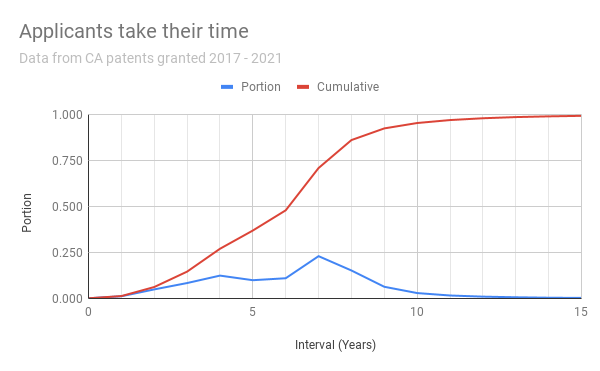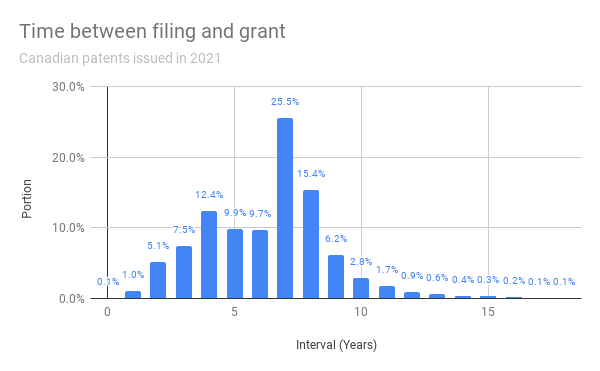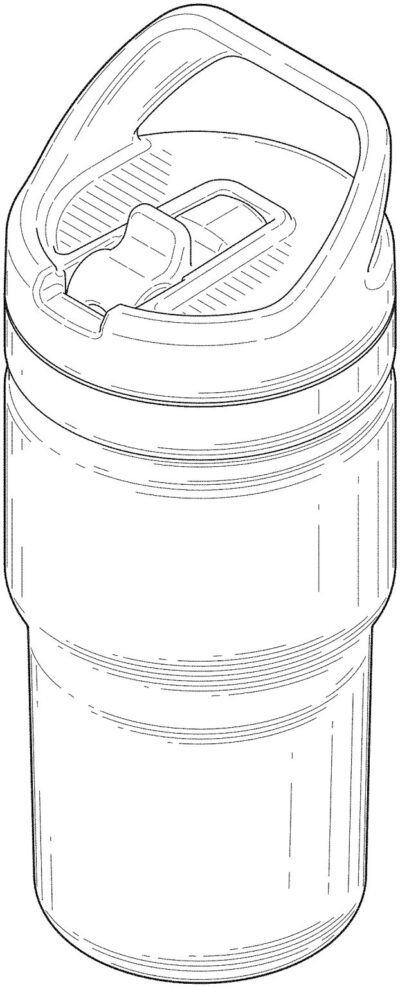It takes about six years from your filing date to get a patent issued in Canada. You have options to reduce or increase this time and there are reasons to want to do either.
Six or seven years for a Canadian patent
The data shows a broad range from the filing date to the issue date. A small number of patents do issue in the same year they are filed – roughly 0.1% of cases. About as many patents are granted seventeen (17) years after filing. The mean and median times are over six (6) years but the mode is at seven (7) years.

At ten (10) years 95% of the cases that will become patents have become a patent.
The data is from patents granted in the five years over 2017 – 2021. Here we look at counts of patents filed in 2003 – 2021 and granted in 2017 – 2021. Then for each pair of years (i.e., filing and grant), we have a count and an interval (i.e., 0, 1, 2, or more years). Finally, we aggregate by interval.
The long tail
Looking at 2021 grants you can see patents were granted up to and after 18 years since filing. This is a long time. The bump at 4 years is typical of other years.

How long for a US patent?
In the US it takes about 26 months to go from filing to a disposal (i.e., grant or abandonment). The US maintains some useful dashboards that show recent pendency values and 24 months of trailing data.
Note we don’t have a disposal date for Canadian applications so we can’t compare the US and Canadian values. It would be nice to pull the bibliographic data for all Canadian patent applications since 1989 but generally the value in the analytics isn’t worth the work.
The USPTO has a nice first office action estimator.
Why does it seem like it takes longer in Canada?
Good question. Mostly it is because applicants in Canada don’t want a patent quickly. They wait years before requesting examination of their patent application. For an application that you file now you have up to four (4) years to request examination. Since, a fee is needed many applicants wait.
It takes years after you ask for examination. CIPO tells us that in 2019 – 2020 and 2020 – 2021, the mean time between “ a client’s request for examination and the moment a patent is granted [is] 31.1 months”.
In the US applications are examined in the order in which they are filed. Well, they are routed to examiners and then processed in roughly the order of filing. But you pay your examination fees on filing in the US.
Do you want a patent faster?
This is an important question. The advantage of getting a patent sooner are you have an assertable right. You have the option to go to court to assert it against infringers. This makes the IP more valuable to investors and licensees.
The cost of getting a patent earlier include faster spend and, possibly, smaller scope. Maybe you should have argued harder rather than amend. As well, you spend money faster and often spend more to get a patent faster.
Do you want a patent slower?
This is not just a useful rhetorical exercise. Going slow has advantages.
You spend money slower. This allows you to avoid spending money on a patent application you later abandon.
You have more information on which to prosecute your claims. Sometimes you get claims as filed. Sometimes you must rework them. With time you may learn what is important to claim. For example, you may become aware of a competitor’s product.
Also, remember in Canada you have limited rights to further applications. You can’t file a CON or CIP. So, waiting often has benefits.
Tools to change the pace of examination
There are many tools to change your velocity through the patent office.
Tools to go faster
The internet is full of descriptions of how to prosecute a patent application faster. Many of these involve more work and money from you the applicant. U.S. programs include accelerated examination, which we don’t recommend, Track One examination, and the Patent Prosecution Highway. In Canada you can expedite examination for green technology, for applications related to COVID-19, or under a special order.
Three low-cost or free tools are:
- Any patent office – Present reasonable claims.
- US – Information Disclosure Statements (IDSs). A timely IDS helps prevent needless Requests for Continued Examination (RCE).
- CA – Patent
Prosecution Highway (PPH). There is no official fee for requesting your
application be expedited under the PPH.
- The Japanese patent office maintains data on the PPH program which shows that CIPO will issue an office action within two months of you making a PPH request. It is also 6 to 8 times more likely to be a first action allowance. However, note these quick allowances are still rare. Ultimately, applicants are better off using the PPH program.
Tools to go slower
You can slow down your application. These are examples of some tools:
- US
- Provisional application – A U.S. provisional application is a very useful tool for an IP owner. A provisional is an informal application you file with the United States Patent Office to get an extra year of patent term.
- RCE – You can always file an RCE but you must amend the application or submit a new IDS.
- Filing in a slow art unit. You can craft claims to direct your application to a group in the patent office that has a long backlog.
- Canada
- Delaying your examination request – You can wait until the last month to request examination.
- Delaying responses to office actions.
Discussion
This data is for all patent applications. If you would like know more so you can plan your patent portfolio please contact us.



